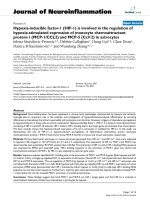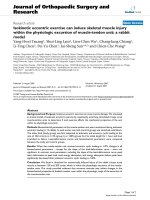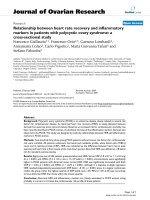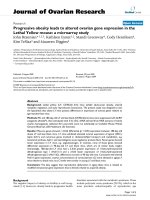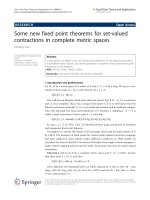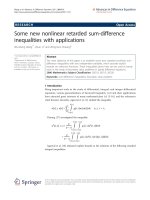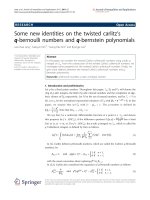Báo cáo hóa học: " Some new nonlinear integral inequalities and their applications in the qualitative analysis of differential equations" potx
Bạn đang xem bản rút gọn của tài liệu. Xem và tải ngay bản đầy đủ của tài liệu tại đây (357.42 KB, 15 trang )
RESEARC H Open Access
Some new nonlinear integral inequalities and
their applications in the qualitative analysis of
differential equations
Bin Zheng
1*
and Qinghua Feng
1,2
* Correspondence:
1
School of Science, Shandong
University of Technology, Zibo,
Shandong 255049, China
Full list of author information is
available at the end of the article
Abstract
In this paper, some new nonlinear integral inequalities are established, which provide
a handy tool for analyzing the global existence and boundedness of solutions of
differential and integral equations. The established results generalize the main results
in Sun (J. Math. Anal. Appl. 301, 265-275, 2005), Ferreira and Torres (Appl. Math. Lett.
22, 876-881, 2009), Xu and Sun (Appl. Math. Comput. 182, 1260-1266, 2006) and Li
et al. (J. Math. Anal. Appl. 372, 339-349 2010).
MSC 2010: 26D15; 26D10
Keywords: integral inequality, global existence, integral equation, differential equa-
tion, bounded
1 Introduction
During the past decades, with the development of the theory of differential and integral
equations, a lot of integral inequalities, for example [1-12], have been discovered,
which play an important role in the research of boundedness, global existence, stability
of solutions of differential and integral equations.
In [9], the following two theorems for retarded integral inequalities were established.
Theorem A: R
+
=[0,∞). Let u, f, g be nondecreasing continuous functions defined
on R
+
and let c be a nonnegative constant. Moreover, let ω Î C(R
+
, R
+
) be nondecreas-
ing with ω(u) >0on(0,∞)anda Î C
1
(R
+
, R
+
) be nondecreasing with a(t) ≤ t on R
+
.
m, n are constants, and m>n>0. If
u
m
(t ) ≤ c
m
m−n
+
m
m − n
α
(
t
)
0
[f (s)u
n
(s)ω(u(s)) + g(s)u
n
(s)] ds, t ∈ R
+
,
then for t Î [0, ξ]
u(t ) ≤{Ω
−1
[Ω(c +
α(t)
0
g(s)ds)+
α(t)
0
f (s)ds]}
1
m−n
,
where
Ω
(r)=
r
1
1
ω
(
s
1
m−n
)
d
s
, r >0,Ω
-1
is the inverse of Ω, Ω (∞)=∞,andξ Î R
+
is chosen so that
Ω
(c +
α(t)
0
g(s)ds)+
α(t)
0
f (s)ds ∈ Dom(Ω
−1
)
.
Zheng and Feng Journal of Inequalities and Applications 2011, 2011:20
/>© 2011 Zheng and Feng; licensee Springer. This is an Open Access article distributed under the terms of the Creative Commons
Attribution License ( which permits unrestricted use, distribution, and reproduction in
any medium, provided the original work is properly cited .
Theorem B: Under the hypothesis of Theorem B, if
u
m
(t) ≤ c
m
m−n
+
m
m − n
α(t)
0
f (s)u
n
(s)ω(u(s ))ds+
m
m − n
t
0
g(s)u
n
(s)ω(u(s ))ds, t ∈ R
+
,
then for t Î [0, ξ]
u
(t ) ≤{Ω
−1
[Ω(c)+
α(t)
0
f (s)ds +
t
0
g(s)ds]}
1
m−n
.
Recently, in [10], the author provided a more general result.
Theorem C:
R
+
0
=[0,∞
)
, R
+
= (0, ∞). Let f(t, s) and
g
(t , s) ∈ C(R
+
0
× R
+
0
, R
+
0
)
be nonde-
creasing in t for every s fixed. Moreover, let
φ ∈ C(R
+
0
, R
+
0
)
beastrictlyincreasingfunc-
tion such that
l
im
x
→∞
φ
(
x
)
=
∞
and suppose that
c ∈ C(R
+
0
, R
+
)
is a nondecreasing
function. Further , let
η, ω ∈ C(R
+
0
, R
+
0
)
be nondecreasing with {h , ω}(x) >0forx Î (0, ∞)
and
∞
x
0
1
η(φ
−1
(s))
ds =
∞
,withx
0
defined as below. Finally, assume that
α ∈ C
1
(R
+
0
, R
+
0
)
is nondecreasing with a(t) ≤ t.If
u ∈ C(R
+
0
, R
+
0
)
satisfies
φ(u(t)) ≤ c(t)+
α(t)
0
[f (t, s)η(u(s))ω(u(s)) + g(t, s)η(u(s))]ds, t ∈ R
+
0
then there exists τ Î R
+
so that for all t Î [0, τ] we have
ψ(p(t)) +
α
(
t
)
0
f (t, s) ds ∈ Dom (ψ
−1
)
,
and
u
(t ) ≤ φ
−1
{G
−1
(ψ
−1
[ψ(p(t)) +
α(t)
0
f (t, s)ds])}
,
where
G(x)=
x
x
0
1
η(φ
−1
(s))
ds
.
with x ≥ c(0) >x
0
>0if
x
0
1
η
(
φ
−1
(
s
))
ds =
∞
and x ≥ c(0) >x
0
≥ 0if
x
0
1
η(φ
−1
(s))
ds < ∞.
p(t)=G(c(t)) +
α(t)
0
g(t, s)ds,
ψ(x)=
x
x
1
1
ω(φ
−1
(G
−1
(s)))
, x > 0, x
1
> 0
.
Here G
-1
and ψ
-1
are inverse functions of G and ψ, respectively.
In [11], Xu presented the following two theorems:
Theorem D: R
+
=[0,∞). Let u, f, g be real-valued nonnegative continuous functions
defined for x ≥ 0, y ≥ 0 and let c be a nonnegative constant. Moreover, let ω Î C(R
+
, R
+
)
be nondecreasing with ω( u) >0on(0,∞)anda, b, Î C
1
(R
+
, R
+
) be nondecreasing with
a(x) ≤ x, b(y) ≤ y on R
+
. m, n are constants, and m>n>0. If
u
m
(x, y) ≤a(x)+b(y)+
m
m − n
α
(
x
)
0
β
(
y
)
0
[f (t, s)u
n
(t , s)ω(u(t, s)
)
+ g
(
t, s
)
u
n
(
t, s
)
] dsdt, x, y ∈ R
+
,
Zheng and Feng Journal of Inequalities and Applications 2011, 2011:20
/>Page 2 of 15
then for x Î [0, ξ], y Î [0, h]
u
(x, y) ≤{Ω
−1
[Ω(p(x, y)) +
α(x)
0
β(y)
0
f (t, s)dsdt]}
1
m−n
,
where
p(x, y)=[a(0) + b(y)]
m−n
m
+
m − n
m
x
0
a
(t )
[a(t)+b(0)]
n
m
d
t
+
α(x)
0
β(y)
0
g( t, s) dsdt,
Ω is defined as in Theorem A, and ξ, h are chosen so that
Ω
(p(x, y)) +
α(x)
0
β(y)
0
f (t, s) dsdt ∈ Dom(Ω
−1
)
.
Theorem E : Under the hypothesis of Theorem D, if
u
m
(x, y) ≤a(x)+b(y)+
m
m − n
α
(
x
)
0
β
(
y
)
0
f (t, s)u
n
(t , s)ω(u(t, s))dsd
t
+
m
m − n
x
0
y
0
g(t, s)u
n
(t , s)ω(u(t, s))dsdt, x, y ∈ R
+
,
then
u
(x, y) ≤{Ω
−1
[Ω(q(x, y)) +
α(x)
0
β(y)
0
f (t, s)dsdt +
x
0
y
0
g(t, s)dsdt]}
1
m−n
where
q(x, y)=[a(0) + b(y)]
m−n
m
+
m − n
m
x
0
a
(t )
[a
(
t
)
+ b
(
0
)
]
n
m
dt
.
In this paper, motivated by the above work, we will prove more general theorems
and establish some new integral inequalities. Also we will give some examples so as to
illustrate the validity of the present integral inequalities.
2 Main results
In the rest of the paper we denote the set of real numbers as R,andR
+
=[0,∞)isa
subset of R. Dom(f)andIm(f) denote the definition domain and the image of f,
respectively.
Theorem 2.1: Assume that x, a Î C(R
+
, R
+
)anda(t) is nondecreasing. f
i
, g
i
, h
i
, ∂
t
f
i
,
∂
t
g
i
, ∂
t
h
i
Î C(R
+
× R
+
, R
+
), i =1,2.Letω Î C(R
+
, R
+
) be nondecreasing with ω(u) >0
on (0, ∞). p, q are constants, and p>q>0. If a Î C
1
(R
+
, R
+
) is nondecreasing with a
(t) ≤ t on R
+
, and
x
p
(t ) ≤ a(t)+
α
(
t
)
0
[f
1
(s, t)x
q
(s)ω(x(s)) + g
1
(s, t)x
q
(s)+
s
0
h
1
(τ , t)x
q
(τ )dτ ] d
s
+
t
0
[f
2
(s, t)x
q
(s)ω(x(s)) + g
2
(s, t)x
q
(s)+
s
0
h
2
(τ , t)x
q
(τ )dτ ]ds, t ∈ R
+
,
(1)
then there exists
t ∈ R
+
such that for
t ∈
[
0, t
]
x(t) ≤{Ω
−1
{Ω(H(t)) +
p − q
p
[
α(t)
0
f
1
(s, t)+
t
0
f
2
(s, t)ds]}}
1
p−q
,
(2)
Zheng and Feng Journal of Inequalities and Applications 2011, 2011:20
/>Page 3 of 15
where
H(t)=a
p
−q
p
(t )+
p − q
p
{
α(t)
0
[g
1
(s, t)+
s
0
h
1
(τ , t)dτ ] d
s
+
t
0
[g
2
(s, t)+
s
0
h
2
(τ , t)dτ ] ds}
,
(3)
Ω
(r)=
r
1
1
ω
(
s
1
p−q
)
d
s
, r >0.Ω
-1
is the inverse of Ω, and Ω (∞)=∞.
Proof: The proof for the existence of
t
can be referred to Remark 1 in [10]. We
notice (3) obviously holds for t =0.Nowgivenanarbitrarynumber
T ∈
(
0, t
]
,fort Î
(0, T], we have
x
p
(t ) ≤a(T)+
α(t)
0
[f
1
(s, t)x
q
(s)ω(x(s)) + g
1
(s, t)x
q
(s)+
s
0
h
1
(τ , t)x
q
(τ )dτ ] d
s
+
t
0
[f
2
(s, t)x
q
(s)ω(x(s)) + g
2
(s, t)x
q
(s)+
s
0
h
2
(τ , t)x
q
(τ )dτ ] ds.
(4)
Let the right-hand side of (4) be z(t), then x
p
(t) ≤ z(t) and x
p
(a(t)) ≤ z(a (t)) ≤ z(t). So
z
(t)=[f
1
(α(t), t)x
q
(α(t))ω(x(α(t))) + g
1
(α(t), t)x
q
(α(t)) +
α(t)
0
h
1
(τ , t)x
q
(τ )dτ]α
(t
)
+
α(t)
0
[
∂f
1
(s, t)
∂t
x
q
(s)ω(x ( s )) +
∂g
1
(s, t)
∂t
x
q
(s)+
∂
s
0
h
1
(τ , t)x
q
(τ )dτ
∂t
] ds
+[f
2
(t, t)x
q
(t)ω(x(t)) + g
2
(t, t)x
q
(t)+
t
0
h
2
(τ , t)x
q
(τ )dτ]
+
t
0
[
∂f
2
(s, t)
∂t
x
q
(s)ω(x ( s )) +
∂g
2
(s, t)
∂t
x
q
(s)+
∂
s
0
h
2
(τ , t)x
q
(τ )dτ
∂t
] ds
≤{[f
1
(α(t), t)ω(x(α(t))) + g
1
(α(t), t)+
α(t)
0
h
1
(τ , t)dτ]α
(t)
+
α(t)
0
[
∂f
1
(s, t)
∂t
ω(x(s)) +
∂g
1
(s, t)
∂t
+
∂
s
0
h
1
(τ , t)dτ
∂t
] ds
+[f
2
(t, t)ω(x(t)) + g
2
(t, t)+
t
0
h
2
(τ , t)dτ]
+
t
0
[
∂f
2
(s, t)
∂t
ω(x(s)) +
∂g
2
(s, t)
∂t
+
∂
s
0
h
2
(τ , t)dτ
∂t
]ds}z
q
p
(t)
Then
z
(t )
z
q
p
(t )
≤
d
α(t)
0
[f
1
(s, t)ω(x(s)) + g
1
(s, t)+
s
0
h
1
(τ , t)dτ ] ds
dt
+
d
t
0
[f
2
(s, t)ω(x(s)) + g
2
(s, t)+
s
0
h
2
(τ , t)dτ ] ds
dt
.
(5)
An integration for (5) from 0 to t, considering z(0) = a(T), yields
z
p−q
p
(t ) ≤a
p−q
p
(T)+
p − q
p
{
α(t)
0
[f
1
(s, t)ω(x(s)) + g
1
(s, t)+
s
0
h
1
(τ , t)dτ ] d
s
+
t
0
[f
2
(s, t)ω(x(s)) + g
2
(s, t)+
s
0
h
2
(τ , t)dτ ]ds}.
(6)
Zheng and Feng Journal of Inequalities and Applications 2011, 2011:20
/>Page 4 of 15
Then
z
p−q
p
(t ) ≤ H(T)+
p − q
p
[
α(t)
0
f
1
(s, t)ω(z
1
p
(s)) +
t
0
f
2
(s, t)ω(z
1
p
(s))ds]
.
(7)
Let the right-hand side of ( 7) be y(t). Then we have
z
p−q
p
(
t
)
≤ y
(
t
)
,
z
p
−q
p
(
α
(
t
))
≤ y
(
α
(
t
))
≤ y
(
t
)
, and
y
(t )=
p − q
p
[f
1
(α(t), t)ω(z
1
p
(α(t)))α
(t )+
α
(
t
)
0
∂f
1
(s, t)
∂t
ω(z
1
p
(s)) d
s
+ f
2
(t , t) ω(z
1
p
(t )) +
t
0
∂f
2
(s, t)
∂t
ω(z
1
p
(s))ds]
≤
p − q
p
d[
α(t)
0
f
1
(s, t)+
t
0
f
2
(s, t)ds]
dt
ω(y
1
p−q
(t )),
(8)
that is
y
(t )
ω
(
y
1
p−q
(
t
))
≤
p − q
p
d[
α(t)
0
f
1
(s, t)+
t
0
f
2
(s, t)ds]
dt
.
(9)
Integrating (9) from 0 to t, considering y(0) = H(T), it follows
Ω
(y(t)) − Ω(H(T)) ≤
p − q
p
[
α(t)
0
f
1
(s, t)+
t
0
f
2
(s, t)ds]
.
(10)
So
x(t) ≤ z
1
p
(t ) ≤ y
1
p − q
(t ) ≤
{Ω
−1
{Ω(H(T)) +
p − q
p
[
α(t)
0
f
1
(s, t)+
t
0
f
2
(s, t)ds]}}
1
p−q
, t ∈ (0, t]
.
(11)
Taking t = T in (11), then
x(T) ≤{Ω
−1
{Ω(H(T)) +
p − q
p
[
α(T)
0
f
1
(s, T)+
T
0
f
2
(s, T)ds]}}
1
p−q
,
Consideri ng
T ∈
(
0, t
]
is arbitrary, substituting T with t, and then the proof is
complete.
Remark 1 : We note that the right-hand side of (2) is well defined since Ω (∞)=∞.
Remark 2 :Ifwetakep =2,q =1,ω(u)=u, h
1
(s, t)=h
2
(s, t) ≡ 0orp =2,q =1,h
1
(s,
t)=h
2
(s, t) ≡ 0, respectively, then our Theorem 2.1 reduces to [12, Theorems 2.1, 2.2].
Corollary 2.1: Assume that x, a, a, ω, Ω are defined as in Theorem 2.1. f
i
, g
i
, h
i
Î C
(R
+
, R
+
), m
i
, n
i
, l
i
Î C
1
(R
+
, R
+
), i =1,2.If
x
p
(t ) ≤ a(t)+
α(t)
0
[m
1
(t ) f (s)x
q
(s)ω(x(s)) + n
1
(t ) g
1
(s)x
q
(s)
+
s
0
l
1
(t ) h
1
(τ )x
q
(τ )dτ ]ds +
t
0
[m
2
(t ) f
2
(s)x
q
(s)ω(x(s)) + n
2
(t ) g
2
(s)x
q
(s
)
+
s
0
l
2
(t ) h
2
(τ )x
q
(τ )dτ ]ds, t ∈ R
+
,
(12)
Zheng and Feng Journal of Inequalities and Applications 2011, 2011:20
/>Page 5 of 15
then we can find some
t ∈ R
+
such that for
t ∈
[
0, t
]
x(t) ≤{Ω
−1
{Ω(H(t)) +
p − q
p
[
α(t)
0
m
1
(t ) f
1
(s)ds +
t
0
m
2
(t ) f
2
(s)ds]}}
1
p−q
,
(13)
where
H(t)=a
p−q
p
(t )+
p − q
p
{
α(t)
0
[n
1
(t ) g
1
(s)+
s
0
l
1
(t ) h
1
(τ )dτ ] d
s
+
t
0
[n
2
(t ) g
2
(s)+
s
0
l
2
(t ) h
2
(τ )dτ ] ds}.
(14)
Remark 3:If
a
(
t
)
≡ C
p
p−q
, m
1
(t)=n
1
(t) ≡ 1, l
1
(t) ≡ 0, m
2
(t)=n
2
(t)=l
2
(t) ≡ 0 for t Î
R
+
, then Corolla ry 1 reduces to Theorem A [9, Theorem 2.1]. If
a
(
t
)
≡ C
p
p−q
, m
1
(t) ≡
1, g
1
(t) ≡ 0, l
1
(t) ≡ 0, m
2
(t) ≡ 1, n
2
(t)=l
2
(t) ≡ 0fort Î R
+
, then Corollary 2.1 reduce s
to Theorem B [9, Theorem 2.2].
Corollary 2:2:Assumethatx, a, a, ω, Ω are defined as in Theorem 2.1. f, g, h, ∂
t
f,
∂
t
g, ∂
t
h Î C(R
+
× R
+
, R
+
). If
x
p
(t) ≤ a(t)+
α(t)
0
[f (s, t)x
q
(s)ω( x ( s )) + g(s, t)x
q
(s)+
s
0
h(τ , t)x
q
(τ )dτ ] ds, t ∈ R
+
,
(15)
then for
t ∈
[
0, t
]
x(t) ≤{Ω
−1
[Ω(H(t)) +
p − q
p
α
(
t
)
0
f (s, t)ds]}
1
p−q
,
(16)
where
H(t)=a
p−q
p
(t )+
p − q
p
{
α(t)
0
[g(s, t)+
s
0
h(τ , t)dτ ] ds}
.
(17)
Corollary 2:3: Assume that x, a, a, ω, Ω are defined as in Theorem 2.1. f, g, h Î C(R
+
, R
+
), m, n, l Î C
1
(R
+
, R
+
). If
x
p
(t ) ≤a(t)+
α(t)
0
[m(t)f (s)x
q
(s)ω(x(s)) + n(t)g(s)x
q
(s
)
+
s
0
l(t ) h( τ )x
q
(τ )dτ ]ds, t ∈ R
+
,
(18)
then for
t ∈
[
0, t
]
x(t) ≤{Ω
−1
[Ω(H(t)) +
p − q
p
α(t)
0
m(t ) f (s)ds]}
1
p−q
,
(19)
where
H(t)=a
p−q
p
(t )+
p − q
p
{
α(t)
0
[n(t)g(s)+
s
0
l(t ) h( τ )dτ ] ds}
.
(20)
Motivated by Corollary 2.2 and Theorem C [10], we will give the following more
general theorem:
Theorem 2:2: Assume that f(s, t), g(s, t), h(s, t) Î C(R
+
× R
+
, R
+
) are nondecreasing
in t for each s fixed, and j Î C(R
+
, R
+
) is a strictly increasing function with
Zheng and Feng Journal of Inequalities and Applications 2011, 2011:20
/>Page 6 of 15
lim
x
→
∞
φ(x)=
∞
. ψ, ω Î C(R
+
, R
+
) are nondecreasing with ψ (x) >0, ω(x) >0forx Î
(0, ∞)and
∞
t
0
1
ψ(φ
−1
(s))
ds =
∞
, a(t), a(t) are defined as in Theorem 2.1, and a(0) >
t
0
>0. If x Î C(R
+
, R
+
) satisfies the following integral inequality containing multiple
integrals
φ(x(t)) ≤ a(t)+
α
1
(t)
0
f (s, t)ψ(x(s))ds +
α
2
(t)
0
g(s, t)ψ(x(s))ω(x(s))d
s
+
α
3
(t)
0
s
0
h(τ , t)ψ(x(τ ))dτ ds ,
(21)
then we can find some
t ∈ R
+
such that for
t ∈
[
0, t
]
Y(H( t)) +
α
2
(t)
0
g(s, t)ds ∈ Dom(Y
−1
)
,
and
x(t) ≤ φ
−1
{J
−1
[Y
−1
(Y(H ( t)) +
α
2
(
t
)
0
g(s, t)ds)]}
,
(22)
where
H(t)=J(a(t)) +
α
1
(t)
0
f (s, t)ds +
α
3
(t)
0
s
0
h(τ , t)dτ ds
,
(23)
J
(t )=
t
t
0
1
ψ(φ
−1
(s))
ds, t > t
0
, Y(t)=
t
t
1
1
ω(φ
−1
(J
−1
(s)))
ds, t
1
> 0, t > 0
.
(24)
Proof: The proof for the existence of
t
can be referred to Remark 1 in [10]. We
notice (22) obviously holds for t = 0. Now given an arbitrary number T>0,
T ∈
(
0, t
]
.
Define
d(t)=a(T)+
α
1
(
t
)
0
f (s, T)ψ(x(s))ds +
α
2
(
t
)
0
g(s, T)ψ(x(s))ω(x(s))d
s
+
α
3
(t)
0
s
0
h(τ , T)ψ( x ( τ ))dτ ds.
Then for t Î (0, T],
x
(
t
)
≤ φ
−1
(
d
(
t
)),
(25)
and
d
(t )=f (α
1
(t ), T)ψ(x(α
1
(t )))α
1
(t )+g(α
2
(t ), T)ψ(x(α
2
(t )))ω(x(α
2
(t )))α
2
(t
)
+ α
3
(t )
α
3
(t)
0
h(τ , T)ψ( x ( τ ))dτ
≤ f (α
1
(t ), T)ψ(φ
−1
(d(α
1
(t ))))α
1
(t )+g(α
2
(t ), T)ψ(φ
−1
(d(α
2
(t ))))
ω(φ
−1
(d(α
2
(t ))))α
2
(t )+α
3
(t ) ψ (φ
−1
(d(α
3
(t ))))
α
3
(t)
0
h(τ , T)dτ
≤ f (α
1
(t ), T)ψ(φ
−1
(d(t)))α
1
(t )+g( α
2
(t ), T)ψ(φ
−1
(d(t)))
ω(φ
−1
(d(α
2
(t ))))α
2
(t )+α
3
(t ) ψ (φ
−1
(d(t)))
α
3
(t)
0
h(τ , T)dτ .
(26)
Zheng and Feng Journal of Inequalities and Applications 2011, 2011:20
/>Page 7 of 15
So
d
(t )
ψ(φ
−1
(d(t)))
≤f (α
1
(t ), T)α
1
(t )+g(α
2
(t ), T)ω(φ
−1
(d(α
2
(t ))))α
2
(t
)
+ α
3
(t )
α
3
(t)
0
h(τ , T)dτ .
(27)
Integrating (27) from 0 to t, considering J is increasing, we can obtain
d(t) ≤ J
−1
[J(a(T)) +
α
1
(
t
)
0
f (s, T)ds +
α
2
(
t
)
0
g(s, T)ω(φ
−1
(d(s)))d
s
+
α
3
(t)
0
s
0
h(τ , T)dτ ds]
≤ J
−1
[H(T)+
α
2
(t)
0
g(s, T)ω(φ
−1
(d(s)))ds], t ∈ (0, T].
(28)
Define
G(t )=H( T)+
α
2
(t)
0
g(s, T)ω(φ
−1
(d(s)))d
s
, then
d
(
t
)
≤ J
−1
(
G
(
t
))
, t ∈
(
0, T]
,
(29)
and
G
(t )=g( α
2
(t ), T)ω(φ
−1
(d(α
2
(t ))))α
2
(t )
≤ g( α
2
(t ), T)ω(φ
−1
(J
−1
(G(α
2
(t )))))α
2
(t )
≤ g
(
α
2
(
t
)
, T
)
ω
(
φ
−1
(
J
−1
(
G
(
t
)))
α
2
(
t
)
,
(30)
that is,
G
(t )
ω
(
φ
−1
(
J
−1
(
G
(
t
)))
≤ g( α
2
(t ), T)α
2
(t )
.
(31)
Integrating (31) from 0 to t, considering
G
(
0
)
= H
(
T
)
and Y is increasing, it follows
G(t ) ≤ Y
−1
[Y( H(T)) +
α
2
(t)
0
g(s, T)ds], t ∈ (0, T]
.
(32)
Combining (25), (29) and (32) we have
x(t) ≤ φ
−1
{J
−1
[Y
−1
(Y(H ( T)) +
α
2
(t)
0
g(s, T)ds)]}, t ∈ (0, T]
.
(33)
Taking t = T in (33), it follows
x(T) ≤ φ
−1
{J
−1
[Y
−1
(Y(H ( T)) +
α
2
(T)
0
g(s, T)ds)]}
.
Considering
T ∈
(
0, t
]
is arbitrary, substituting T with t we have completed the proof.
Remark 4:Ifh(s, t) ≡ 0, a
1
(t)=a
2
(t)=a(t), then Theorem 2.2 becomes Theorem C
[10, Theorem 1].
Now we will apply the concept of establishing Theorem 2.2 to the situation with two
independent variables.
Theorem 2:3: Assume that f
i
(x, y), g
i
(x, y), h
i
(x, y) Î C(R
+
× R
+
, R
+
), i =1,2,andj Î C
(R
+
, R
+
) is a strictly increasing function with
lim
x
→
∞
φ(x)=
∞
. a(x, y) Î C(R
+
× R
+
, R
+
)is
Zheng and Feng Journal of Inequalities and Applications 2011, 2011:20
/>Page 8 of 15
nondecreasing in x for every fixed y and nondecreasing in y for every fixed x. a(x), b(y) Î
C
1
(R
+
, R
+
) are nondecreasing with a(x) ≤ x, b(y ) ≤ y. ψ, ω Î C(R
+
, R
+
) are nondecreasing
with ψ(x) >0, ω(x) >0 for x Î (0, ∞) and
∞
t
0
1
ψ(φ
−1
(s))
ds =
∞
, where 0 <t
0
<a(0, 0).
If u Î C(R
+
× R
+
, R
+
) satisfies the following integral inequality containing multiple
integrals
φ(u(x, y)) ≤ a(x, y)+
β(y)
0
α(x)
0
[f
1
(s, t)ψ(u( s , t )) + g
1
(s, t)ψ(u( s , t ))ω(u(s, t)
)
+
t
0
s
0
h
1
(ξ, τ)ψ(u(ξ, τ))dξdτ ]dsdt
+
y
0
x
0
[f
2
(s, t)ψ(u(s, t)) + g
2
(s, t)ψ(u( s , t ))ω(u(s, t))
+
t
0
s
0
h
2
(ξ, τ)ψ(u(ξ, τ))dξdτ ] dsdt,
(34)
then we can find some
x
>
0
,
y
>
0
so that for all
x ∈
[
0, x
]
,
y
∈
[
0,
y]
Y(
H( x , y)) +
β(y)
0
α(x)
0
g
1
(s, t)dsdt +
y
0
x
0
g
2
(s, t)dsdt ∈ Dom(Y
−1
)
and
u
(x, y) ≤ φ
−1
{J
−1
[Y
−1
(Y(
H( x , y)) +
β
(
y
)
0
α
(
x
)
0
g
1
(s, t) dsd
t
+
y
0
x
0
g
2
(s, t)dsdt)]}
(35)
where J, Y are defined as in Theorem 2.2, and
H(x, y)=J(a(x , y)) +
β(y)
0
α(x)
0
[f
1
(s, t)+
t
0
s
0
h
1
(ξ, τ)dξdτ ] dsd
t
+
y
0
x
0
[f
2
(s, t)+
t
0
s
0
h
2
(ξ, τ)dξdτ ] dsdt.
Proof: The process for seeking for
x
,
y
can also be referred to Remark 1 in [10].
If we take x =0ory = 0, then (35) holds trivially. Now fix
x
0
∈
(
0, x
]
,
y
0
∈
(
0, y
]
,and
x Î (0, x
0
], y Î (0, y
0
]. Let
z
(x, y)=a(x, y
0
)+
β(y)
0
α(x)
0
[f
1
(s, t)ψ(u(s, t)) + g
1
(s, t)ψ(u( s , t ))ω(u(s, t)
)
+
t
0
s
0
h
1
(ξ, τ)ψ(u(ξ, τ))dξdτ ] dsdt
+
y
0
x
0
[f
2
(s, t)ψ(u(s, t)) + g
2
(s, t)ψ(u( s , t ))ω(u(s, t))
+
t
0
s
0
h
2
(ξ, τ)ψ(u(ξ, τ))dξdτ ]dsdt.
(36)
Considering a(x, y) is nondecreasing, we have u(x, y) ≤ j
-1
(z(x, y)) ≤ j
-1
(z(x
0
, y)).
Moreover,
Zheng and Feng Journal of Inequalities and Applications 2011, 2011:20
/>Page 9 of 15
z
y
(x
0
, y)=β
(y)
α(x
0
)
0
[f
1
(s, t)ψ (u(s, β(y))) + g
1
(s, β(y))ψ(u(s, β( y)))ω(u(s, β(y))
)
+
β(y)
0
s
0
h
1
(ξ, τ )ψ(u(ξ ,τ ))dξdτ ] ds
+
x
0
0
[f
2
(s, y)ψ(u(s, y)) + g
2
(s, y)ψ(u(s, y))ω(u(s, y))
+
y
0
s
0
h
2
(ξ, τ )ψ(u(ξ ,τ ))dξdτ ]ds
≤{β
(y)
α(x
0
)
0
[f
1
(s, t)+g
1
(s, β(y))ω(u(s, β(y))) +
β(y)
0
s
0
h
1
(ξ, τ )dξdτ ] ds
+
x
0
0
[f
2
(s, y) ψ(u(s, y)) + g
2
(s, y)ω( u( s , y))
+
y
0
s
0
h
2
(ξ, τ )dξdτ ]ds}ψ(φ
−1
(z(x
0
, y))).
(37)
So
z
y
(x
0
, y)
ψ(φ
−1
(z(x
0
, y)))
≤ β
(y)
α(x
0
)
0
[f
1
(s, β(y)) + g
1
(s, β(y))ω(φ
−1
(z(s, β(y))))
+
β(y)
0
s
0
h
1
(ξ, τ )dξdτ ]ds +
x
0
0
[f
2
(s, y) ψ(u( s , y)) + g
2
(s, y)ω( φ
−1
(z(s, y))
)
+
y
0
s
0
h
2
(ξ, τ )dξdτ ]ds.
(38)
Integrating (38) from 0 to y we have
J(z(x
0
, y)) − J(a(x
0
, y
0
)) ≤
β(y)
0
α(x
0
)
0
[f
1
(s, t)+g
1
(s, t)ω(φ
−1
(z(s, t))) +
t
0
s
0
h
1
(ξ, τ )dξdτ ]dsd
t
+
y
0
x
0
0
[f
2
(s, t)+g
2
(s, t)ω(φ
−1
(z(s, t))) +
t
0
s
0
h
2
(ξ, τ )dξdτ ]dsdt.
(39)
Let
u(x
0
, y)=J(a(x
0
, y
0
)) +
β(y)
0
α(x
0
)
0
[f
1
(s, t)+g
1
(s, t)ω(φ
−1
(z(s, t)))
+
t
0
s
0
h
1
(ξ, τ )dξdτ ] dsdt +
y
0
x
0
0
[f
2
(s, t)+g
2
(s, t)ω(φ
−1
(z(s, t))
)
+
t
0
s
0
h
2
(ξ, τ )dξdτ ] dsdt.
(40)
Then
z
(x
0
, y) ≤ J
−1
[u(x
0
, y)]
≤ J
−1
[
H(x
0
, y
0
)+
β(y)
0
α(x
0
)
0
g
1
(s, t)ω(φ
−1
(z(s, t)))dsd
t
+
y
0
x
0
0
g
2
(s, t)ω(φ
−1
(z(s, t)))dsdt].
Furthermore let
v(x
0
, y)=
H(x
0
, y
0
)+
β
(
y
)
0
α
(
x
0
)
0
g
1
(s, t)ω(φ
−1
(z(s, t))) dsd
t
+
y
0
x
0
0
g
2
(s, t)ω(φ
−1
(z(s, t))) dsdt.
Zheng and Feng Journal of Inequalities and Applications 2011, 2011:20
/>Page 10 of 15
Then
z(
x
0
, y
)
≤ J
−
1
[v
(
x
0
, y
)
]
,
(41)
and
v
y
(x
0
, y)=β
(y)
α
(
x
0
)
0
g
1
(s, β(y))ω(φ
−1
(z(s, β(y)))) ds
+
x
0
0
g
2
(s, y)ω(φ
−1
(z(s, y))) ds
≤ [β
(y)
α(x
0
)
0
g
1
(s, β(y))ds +
x
0
0
g
2
(s, y)ds]ω(φ
−1
(J
−1
(v(x
0
, y))))
,
that is,
v
y
(x
0
, y)
ω
(
φ
−1
(
J
−1
(
v
(
x
0
, y
))))
≤ β
(y)
α(x
0
)
0
g
1
(s, β(y))ds +
x
0
0
g
2
(s, y)ds
.
(42)
Integrating (42) from 0 to y, considering
v
(
x
0
,0
)
=
H
(
x
0
, y
0
)
we have
Y(v(x
0
, y)) − Y(
H( x
0
, y
0
)) ≤
β(y)
0
α(x
0
)
0
g
1
(s, t)dsdt +
y
0
x
0
0
g
2
(s, t) dsdt.e
i
θ
Then
v(x
0
, y) ≤ Y
−1
[Y(
H( x
0
, y
0
)) +
β
(
y
)
0
α
(
x
0
)
0
g
1
(s, t)dsdt +
y
0
x
0
0
g
2
(s, t) dsdt]
,
and
u
(x, y) ≤ φ
−1
[J
−1
(v(x
0
, y))] ≤ φ
−1
{J
−1
[Y
−1
(Y(
H( x
0
, y
0
)
)
+
β(y)
0
α(x
0
)
0
g
1
(s, t)dsdt +
y
0
x
0
0
g
2
(s, t)dsdt)]}.
(43)
Take x = x
0
, y = y
0
and we have
u
(x
0
, y
0
) ≤φ
−1
{J
−1
[Y
−1
(Y(
H(x
0
, y
0
)) +
β(y
0
)
0
α(x
0
)
0
g
1
(s, t)dsd
t
+
y
0
0
x
0
0
g
2
(s, t)dsdt)]}.
(44)
Since
x
0
∈
(
0, x
]
,
y
0
∈
(
0, y
]
are arbitrary, substitute x
0
, y
0
with x, y and the proof is
complete.
Corollary 2.4: Assume that f(x, y), g(x, y), h(x, y) Î C(R
+
× R
+
, R
+
), and a, j, ψ , ω, a,
b, J, Y are defined as in Theorem 2.3. If u Î C(R
+
× R
+
, R
+
) satisfies the following inte-
gral inequality containing multiple integrals
φ(u(x, y)) ≤a(x, y)+
β
(
y
)
0
α
(
x
)
0
[f (s, t)ψ(u(s, t)) + g(s, t)ψ( u( s , t))ω(u(s, t)
)
+
t
0
s
0
h(ξ, τ)ψ(u(ξ, τ))dξdτ ] dsdt,
then we can find some
x
>
0
,
y
>
0
such that for all
x ∈
[
0, x
]
,
y
∈
[
0,
y]
Y(
H( x , y)) +
β(y)
0
α(x)
0
g
1
(s, t) dsdt ∈ Dom(Y
−1
)
,
Zheng and Feng Journal of Inequalities and Applications 2011, 2011:20
/>Page 11 of 15
and
u
(x, y) ≤ φ
−1
{J
−1
[Y
−1
(Y(
H( x , y)) +
β(y)
0
α(x)
0
g(s, t)dsdt)]}
,
where
H(x, y)=J(a(x, y)) +
β(y)
0
α(x)
0
[f (s, t)+
t
0
s
0
h(ξ, τ)dξdτ ] dsdt]
.
Remark 5:Ifwetakeh(x, y) ≡ 0, ψ (u(x, y)) = u
n
(x, y), j(x, y)=u
m
(x, y), m>n>0,
then Corollary 2.4 reduces to Theorem D [11, Theorem 2.1].
Corollary 2.5: Assume that f
i
, g
i
(x, y) Î C(R
+
× R
+
, R
+
), i =1,2,anda, j, ψ, ω, J, Y
are defined as in Theorem 2.3. If u Î C(R
+
× R
+
, R
+
) satisfies the following integral
inequality containing multiple integrals
φ(u(x, y)) ≤ a(x, y)+
β
(
y
)
0
α
(
x
)
0
[f
1
(s, t)ψ (u(s, t)) + g
1
(s, t)ψ (u(s, t))ω(u(s, t))]dsd
t
+
y
0
x
0
[f
2
(s, t)ψ (u(s, t)) + g
2
(s, t)ψ (u(s, t))ω(u(s, t))]dsdt,
then we can find some
x
>
0
,
y
>
0
such that for all
x ∈
[
0, x
]
,
y
∈
[
0,
y]
Y(
H( x , y)) +
β
(
y
)
0
α
(
x
)
0
g
1
(s, t) dsdt +
y
0
x
0
g
2
(s, t) dsdt ∈ Dom(Y
−1
)
,
and
u
(x, y) ≤φ
−1
{J
−1
[Y
−1
(Y(
H(x, y)) +
β(y)
0
α(x)
0
g
1
(s, t) dsd
t
+
y
0
x
0
g
2
(s, t) dsdt)]},
where
H(x, y)=J(a(x, y)) +
β(y)
0
α(x)
0
f
1
(s, t) dsdt +
y
0
x
0
f
2
(s, t) dsdt
.
Remark 6:Ifwetakef
1
(x, y)=f
2
(x, y) ≡ 0, ψ(u(x, y)) = u
n
(x, y), j(x, y)=u
m
(x, y), m
>n, then Corollary 8 reduces to Theorem E [11, Theorem 2.2].
3 Applications
In this section, we will present two examples in order to illustrate the validity of the
above results. In the first example, we will try to prove the global existence of the solu-
tions of a delay differential equation, while in the second example, we will obtain the
bound of the solutions of an integral equation.
For the sake of proving the global existence of solutions of differential equations, we
first recall some basic facts. Consider the following equation
X
(t )=H( t, X(t), X(α(t))
)
X(0) = X
0
(45)
with X
0
Î R
n
, H Î C(R
+
×R
2n
, R
n
), a Î C
1
(R
+
, R
+
) satisfying a(t) ≤ t for t ≥ 0. A
result in [13] guarantees that for every X
0
Î R
n
, Equation 45 has a solution, but the
Zheng and Feng Journal of Inequalities and Applications 2011, 2011:20
/>Page 12 of 15
uniqueness of solutions cannot be guaranteed. Furthermore, every solution of (45) has
a maximal time of existence T>0, and if T<∞, then
lim
t
→∞
sup X(t) =
∞
.
Example 1: Consider the following differential equation group
⎧
⎨
⎩
(x
p
(t ))
= y
p + q
2
(t )+F(x(t), t
)
(y
p
(t ))
= G(t, x(α(t)))
(46)
where p is an ev en number. a(t) is a nond ecreasing function, a(t) Î C
1
(R
+
, R
+
), a(t)
≤ t, ∀t ≥ 0. p>q>0. Assume
|
F
(
x
(
t
)
, t
)
|≤
f
1
(
t
)
|x
q
(
t
)
|v
(
|x|
)
,
f
3
(
t
)
= max
(
1,
˜
f
1
(
t
))
,
f
3
(
t
)
= max
(
1,
˜
f
1
(
t
))
,where
f
1
,
f
2
, v ∈ C
(
R
+
, R
+
)
,
∞
0
1
v
(
s
)
ds =
∞
,
and v is nondecreasing.
Let u
p
(t)=x
p
(t)+y
p
(t), then
(
u
p
(
t
))
=
(
x
p
(
t
))
+
(
y
p
(
t
))
= y
p + q
2
(
t
)
+ F
(
x
(
t
)
, t
)
+ G
(
t, x
(
α
(
t
)))
(47)
If (x( t), y(t)) is a solution of (46) defined on the maximal existence interval [0, T),
integrating (47) from 0 to t, we have
|
u
p
(t ) |≤|u
p
(0)| +
t
0
[|y
p
+ q
2
(s)| + |F(x ( s ), s)| + |G(s, x(α(s )))|] d
s
≤
t
0
[|u
p + q
2
(s)| +
f
1
(s)|x
q
(s)|v(|x|)+
˜
f
2
(s)|x
q
(α(s))|] ds
≤
t
0
[|u
p + q
2
(s)| +
f (s)|u
q
(s)|v(|u|)+
˜
f
2
(s)|u
q
(α(s))|] ds.
Then
|u
p
(t ) |≤|u
p
(0)| +
t
0
[|u
p
+ q
2
(s)| +
f
1
(s)|u
q
(s)|v(|u|)+
f
2
(s)|u
q
(α(s))|] d
s
≤|u
p
(0)| +
t
0
[
f
3
(s)|u
q
(s)|ω( |u|)+
f
2
(s)|u
q
(α(s))|] ds
= |u
p
(0)| +
t
0
f
3
(s)|u
q
(s)|ω( |u|)+
α(t)
0
f
2
(α
−1
r)
α
(
α
−1
r
)
|u
q
(r)|dr,
where
ω
(
|u| = v
(
|u|
)
+ |u
p
− q
2
|
. From Theorem 2.1 we have
|u(t)|≤{Ω
−1
[Ω(|u
p−q
(0)| +
p − q
p
α(t)
0
˜
f
2
(α
−1
r)
α
(α
−1
r)
dr)+
p − q
p
t
0
˜
f
3
(s)ds]}
1
p −
q
= {Ω
−1
[Ω(|u
p−q
(0)| +
p − q
p
t
0
˜
f
2
(s)ds)+
p − q
p
t
0
˜
f
3
(s)ds]}
1
p − q
,0 ≤ t < T.
Obviouslywehave{|x(t)|, |y(t)|} ≤ |u(t)|. So x(t), y(t) do not blow up in finite time.
Then T = ∞, and the solutions of (46) are global.
Zheng and Feng Journal of Inequalities and Applications 2011, 2011:20
/>Page 13 of 15
Example 2: Considering the following integral equation
u
(x, y) ln(u(x, y)+1)=a( x , y)+
β
(
y
)
0
α
(
x
)
0
[F(s, t, u(x, y)) + G(s, t, u(x, y))] dsdt
,
(48)
where u Î C(R
+
× R
+
, R
+
), |F (x, y, u(x, y))| ≤ f(x, y)u(x, y),
|G(x, y, u(x, y))| ≤ g(x, y)u
2
(x, y), f, g Î C(R
+
× R
+
, R
+
), a(x, y), a(x), b(y) are d efined
as in Theorem 2.3.
Let j(u)=uln(u +1),ω (u)=u, h(u)=u. Then one can easily see th e conditions of
Theorem 2.3 are satisfied. So we can obtain the bound of u(x, y)as
u
(x, y) ≤ φ
−1
{J
−1
[Y
−1
(Y(
H(x, y)) +
β
(
y
)
0
α
(
x
)
0
g(s, t)dsdt]}, x ∈ [0, x], y ∈ [0, y]
,
(49)
where
x
,
y
are determined similar to the process in Theorem 2.3, and
H(x, y)=J(a(x, y)) +
β
(
y
)
0
α
(
x
)
0
f (s, t) dsdt
.
Remark 7:wenotethatthemethodsin[1-12]arenotavailablefortheestimateof
bound for the solution of Equation 48.
Acknowledgements
The authors thank the referees very much for their valuable suggestions on this paper.
Author details
1
School of Science, Shandong University of Technology, Zibo, Shandong 255049, China
2
School of Mathematical
Sciences, Qufu Normal University, Qufu, Shandong 273165, China
5 Authors’ contributions
BZ carried out the main part of this article. Both of the two authors read and approved the final manuscript.
4 Competing interests
The authors declare that they have no competing interests.
Received: 9 February 2011 Accepted: 20 July 2011 Published: 20 July 2011
References
1. Li, WN, Han, MA, Meng, FW: Some new delay integral inequalities and their applications. J Comput Appl Math. 180,
191–200 (2005). doi:10.1016/j.cam.2004.10.011
2. Lipovan, O: A retarded integral inequality and its applications. J Math Anal Appl. 285, 436–443 (2003). doi:10.1016/
S0022-247X(03)00409-8
3. Ma, QH, Yang, EH: Some new Gronwall-Bellman-Bihari type integral inequalities with delay. Period Math Hungar. 44(2),
225–238 (2002). doi:10.1023/A:1019600715281
4. Yuan, ZL, Yuan, XW, Meng, FW: Some new delay integral inequalities and their applications. Appl Math Comput. 208,
231–237 (2009). doi:10.1016/j.amc.2008.11.043
5. Lipovan, O: Integral inequalities for retarded Volterra equations. J Math Anal Appl. 322, 349–358 (2006). doi:10.1016/j.
jmaa.2005.08.097
6. Pachpatte, BG: Explicit bounds on certain integral inequalities. J Math Anal Appl. 267,48–61 (2002). doi:10.1006/
jmaa.2001.7743
7. Pachpatte, BG: A note on certain integral inequalities with delay. Period Math Hungar. 31, 234–299 (1995)
8. Pachpatte, BG: On some new nonlinear retarded integral inequalities. J Inequal Pure Appl Math 5,1–8 (2004). (Article
80)
9. Sun, YG: On retarded integral inequalities and their applications. J Math Anal Appl. 301, 265–275 (2005). doi:10.1016/j.
jmaa.2004.07.020
10. Ferreira, RAC, Torres, DFM: Generalized retarded integral inequalities. Appl Math Lett. 22, 876–881 (2009). doi:10.1016/j.
aml.2008.08.022
11. Xu, R, Sun, YG: On retarded integral inequalities in two independent variables and their applications. Appl Math
Comput. 182, 1260–1266 (2006). doi:10.1016/j.amc.2006.05.013
Zheng and Feng Journal of Inequalities and Applications 2011, 2011:20
/>Page 14 of 15
12. Li, LZ, Meng, FW, He, LL: Some generalized integral inequalities and their applications. J Math Anal Appl. 372, 339–349
(2010). doi:10.1016/j.jmaa.2010.06.042
13. Driver, R: Existence and continuous dependence of solutions of neutral functional differential equations. Arch Ration
Mech Anal. 19, 149–166 (1965). doi:10.1007/BF00282279
doi:10.1186/1029-242X-2011-20
Cite this article as: Zheng and Feng: Some new nonlinear integral inequalities and their applications in the
qualitative analysis of differential equations. Journal of Inequalities and Applications 2011 2011:20.
Submit your manuscript to a
journal and benefi t from:
7 Convenient online submission
7 Rigorous peer review
7 Immediate publication on acceptance
7 Open access: articles freely available online
7 High visibility within the fi eld
7 Retaining the copyright to your article
Submit your next manuscript at 7 springeropen.com
Zheng and Feng Journal of Inequalities and Applications 2011, 2011:20
/>Page 15 of 15
